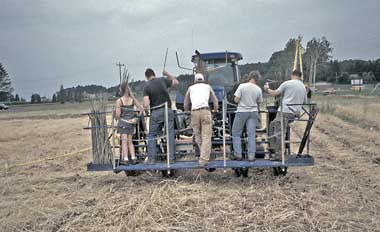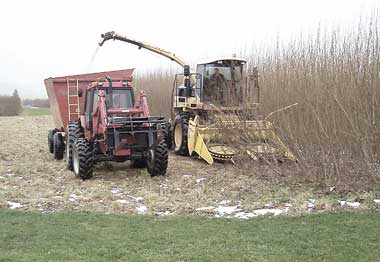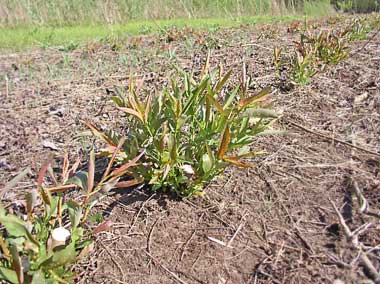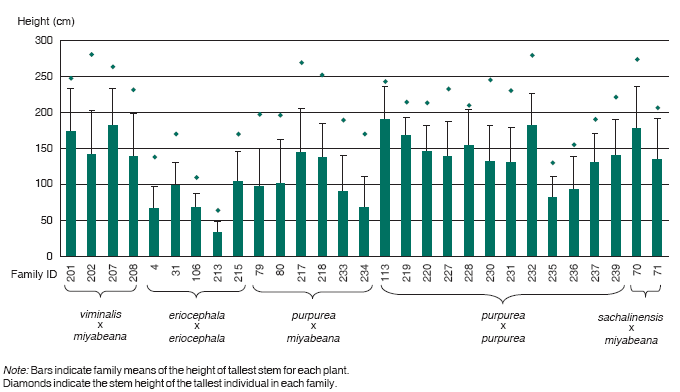


L.B. Smart, T.A. Volk, J. Lin, R.F. Kopp, I.S. Phillips, K.D. Cameron, E.H. White and L.P. Abrahamson
Lawrence B. Smart, Juan Lin, Richard F. Kopp, Ingrid S. Phillips and Kimberly D. Cameron are in the Department of Environmental and Forest Biology, and Timothy A. Volk and Edwin H. White are in the Department of Forest and Natural Resources Management, in the State University of New York (SUNY) College of Environmental Science and Forestry, Syracuse, New York, United States. Lawrence P. Abrahamson is associated with both departments.
A willow breeding programme focuses on improving growth, optimizing relevant traits and lowering production costs to ensure the long-term viability of willow crop systems for producing energy, restoring degraded sites and improving water quality.
Fast-growing shrub willows (Salix spp.) can be bred and selected for use as dedicated energy crops to provide a long-term, sustainable replacement for fossil fuels in temperate regions. They can also be selected for a number of applications besides bioenergy, including phytoremediation (the use of plants to clean up contaminated soils and restore degraded sites), nutrient management, living snow fences and streambank stabilization. Yet despite their outstanding potential for the production of bioenergy and for stimulating rural development (Volk et al., 2004), they have not yet been widely adopted in the United States because of their high cost of production relative to currently used fossil fuels (Tharakan et al., 2005). The development of new willow clones can reduce the cost of willow crops by increasing biomass yields and optimizing wood chemistry for low-input pretreatment, fractionation and conversion in biorefineries.
The willow breeding programme at the College of Environmental Science and Forestry of the State University of New York (SUNY-ESF) is the largest in North America, with over 730 accessions collected from natural sites across the United States and provided by international collaborators. This article describes controlled breeding work carried out at SUNY-ESF which has produced some crosses with growth improved 20 to 40 percent over that of a standard cultivar. The authors believe that such results, if confirmed in regional trials over the long term, could help encourage widespread adoption of willow crops in the United States.
Planting of willow over a rye winter cover crop using a mechanical planter attachment on a tractor |
 |
T. VOLK |
Willow biomass plantations are easily and efficiently established from dormant stem cuttings using mechanical systems. They quickly establish a diffuse root system that is dominated by fine roots. Shrub willows respond to coppicing after the first growing season by prolific production of new stem growth in the second growing season. Above-ground woody biomass is harvested during the dormant season on a three- or four-year rotation by a self-propelled forage harvester with a specialized cutter head. After harvest, modest amounts of nitrogen fertilizer are added to maintain soil nutrition and vigorous growth. During the spring following each harvest, the remaining portion of the willow plant, the stool, responds by producing numerous new stems, initiating a new cycle of growth that can be harvested in another three to four years. This cycle can be repeated for six to eight harvests before the stools need to be replaced.
In the northeastern United States, the plantations are established with willow clones selected for resistance to rust infection, deer and rabbit herbivory and damage by insects, the main threats present. Similar short-rotation forestry systems based on coppicing are being developed in other parts of the world using species other than willow that are adapted to local conditions.
Test of a shrub willow harvester system utilizing a self-propelled forage harvester with a modified cutter head |
 |
L. SMART |
A number of different technologies can be used to convert willow biomass into electricity and heat. It can be burned together with other woody biomass and with coal to generate electricity in existing steam-turbine power plants. When 10 to 15 percent of the coal is replaced with willow biomass, sulphur and nitrogen emissions are reduced by almost an equivalent proportion. Willow biomass can also be combusted along with other wood chips in small-scale wood-burning facilities to generate power and/or steam for commercial or regional residential heating. Emerging technologies will allow more efficient energy conversion in small-scale gasifiers driving diesel or spark ignition generation sets or microturbines.
Since the carbon emitted through combustion of willow biomass was captured from the atmosphere during the growth of the willow over the previous three years – unlike the carbon released from coal combustion, which was captured and fossilized millions of years ago – there is no increase in atmospheric carbon dioxide when power is produced from willow biomass. Energy ratios are favourable: for every unit of fossil fuel energy used to grow, transport and convert willow to electricity, 11 to 16 units of usable electrical energy are produced (Heller, Keoleian and Volk, 2003).
Current research and development efforts are producing efficient methods for the extraction and conversion of wood-derived hemicellulose and cellulose which can be converted to ethanol for fuel or other products currently derived from petroleum.
Shrub willows, as pioneer species, are well adapted to harsh sites and function well in phytoremediation. Their relatively high transpiration rates and ability to withstand seasonal flooding, with roots extending several metres into the ground, are advantageous particularly on wet sites, where control of groundwater runoff is essential for containment of contaminants. Willows used to accumulate heavy metals from the soil can be burned in power plants; the heavy metals are concentrated in the ash for proper disposal.
Native and naturalized shrub willows can also be used to improve water quality and maintain or restore riparian ecosystems. With their rapid growth and short rotations, they can take up excess nitrogen and phosphorus runoff from agricultural activities (Adegbidi et al., 2001). Some of these nutrients are removed from the system at harvest, and the rapid coppice regrowth requires continued high rates of nutrient uptake. Their diffuse and extensive perennial root systems help prevent soil erosion from stream banks, while the shrubs provide wildlife habitat and enhance the landscape.
An emerging application is the use of shrub willows as living snowfences adjacent to windswept roadways. The willows trap blowing snow, thus improving road conditions and reducing costs and environmental impacts associated with repeated mechanical or chemical treatments for snow removal.
Regrowth of new coppice stems from stools of Salix eriocephala in the spring after winter harvest |
 |
L. SMART |
The long-term objectives of the SUNY-ESF programme are to regularly produce new families of shrub willow through breeding and to select improved clones that possess particular suites of traits that make them well suited for specific practical applications (Kopp et al., 2001).
For commercialization in large-scale bioenergy plantations, clones must produce high yields on a diversity of sites over many years to reduce the cost of willow biomass production. SUNY-ESF is seeking clones that possess optimal wood chemistry for low-input pretreatment, separation of wood components (cellulose, hemicellulose and lignin) and conversion to biofuels in biorefineries.
For environmental engineering applications, including the clean-up of contaminated soils and control of nutrient runoff, native and naturalized shrub willows are selected for active heavy metal uptake, ability to support a microbial community that can degrade organic contaminants, high rates of transpiration for hydrologic control, and prolific root growth for soil stabilization and uptake of excess nitrogen and phosphorus from agricultural fertilizers or wastewater. The limited research performed thus far on the use of willows for heavy metal phytoremediation suggests that there is great variation in the ability of different Salix species and species hybrids to take up metals (Landberg and Greger, 2002; Pulford, Riddell-Black and Stewart, 2002; Vyslouzilova et al., 2003). It is highly likely that there is genetic variation among Salix clones in their ability to occupy different types of contaminated soils and promote remediation. Likewise, clones display varying rates of transpiration (Weih and Nordh, 2002), which is an important trait for hydrologic control of contaminated groundwater. Screening of Salix clones for various phytoremediation-related applications can be targeted for particular sites and specific remediation goals.
The programme at SUNY-ESF assembles genetically diverse clones collected from sites across the northeasten and midwestern United States. Collaborators in China, Japan, Canada, New Zealand, Ukraine and Sweden have contributed accessions to the collection. The collection has also acquired a number of clones from commercial nurseries. Since 1994, SUNY-ESF has archived more than 730 accessions of Salix spp., most of them collected and propagated from plants growing in their natural habitat. The most common species in the collection include S. eriocephala, S. purpurea and S. nigra (see Table). These plants are surveyed on a regular basis for characteristics including stem number, stem diameter, height, disease susceptibility and pest damage. Plant growth form is also considered, since compact, vertical growth is optimum for mechnical harvesting. Since willows are dioecious (each plant produces either male or female flowers), their gender is determined. Based on these assessments, individuals are selected as parents for controlled crosses. Molecular genetic technology based on DNA sequence variation is used to assess the genetic diversity of the accessions in the collection, to fingerprint specific clones and to aid in species identification.
A collection to support a long-term breeding programme should capture as wide an array of genetic diversity as possible. Two of the species important to the SUNY-ESF programme are S. eriocephala, native to the northeastern United States, and S. purpurea, introduced to the United States over 200 years ago by European settlers for basket making. To characterize the diversity of the populations from which individuals have been selected for the nursery collection, researchers have collected samples from more than 1 000 individuals of these two species growing along streams in New York State and have analysed genetic variation. Results of these molecular analyses indicated that while natural populations of both species are highly diverse, populations of the native species, S. eriocephala, display greater genetic diversity than the introduced S. purpurea. In fact, some populations of this naturalized species consist of individuals of the same clone that have become established through vegetative propagation (J. Lin and L.B. Smart, unpublished data). Once completed, these analyses will indicate whether collections made to establish the breeding nursery have captured an appropriate subset of the natural genetic diversity.
In addition to assessing the population-level genetic diversity, researchers at SUNY-ESF have also collected data on the heritability of some basic traits in S. eriocephala. Measurements in replicated trials have indicated that heritability is low to moderate for traits important for biomass production (Phillips, 2002). These results suggest that when high-yielding clones are used as parents in crosses, there is a good probability that the offspring will also have high yield based on the genes they inherited. Family means of first-generation progeny are mostly greater than mid-point parental means, indicating that offspring of controlled pollinations can display hybrid vigour. Greenhouse- and field-based studies of second-generation progeny indicated that there is no significant inbreeding depression. Taken together, these results suggest that regular, incremental improvements in the yield of S. eriocephala can be realized through controlled crossing and selection (Phillips, 2002).
Selection of willow clones that will grow vigorously on an industrial waste landfill Shrub willows may play an important role in a site critically in need of environmental remediation near Syracuse, New York, United States. This site contains large volumes of waste generated through the Solvay process for the production of soda ash (sodium carbonate) for the manufacture of glass and bleaches. The Solvay process uses salt and limestone as inputs and produces calcium chloride as a waste by-product. Much of the waste from the operation of the Solvay plant from 1887 to 1986 was deposited as a slurry in large settling basins adjacent to Onondaga Lake. The resulting waste beds have high pH and salt concentrations. Currently, salts are leaching from the Solvay waste into surrounding creeks and Onondaga Lake, contributing to unusually high levels of chloride and calcium which cause significant disturbance to the lake ecosystem. Shrub willows are one of the first woody pioneer species to become established in these harsh conditions (Hewlett, 1956). High-density plantations of shrub willows on waste material augmented with various organic substances are being tested for their ability to reduce or eliminate percolation of water through the waste beds via the interception of precipitation, increased evapotranspiration and increased water-holding capacity of the soil. Initial screening of 38 shrub willow clones on wastebed material in greenhouse and field trials has indicated that there are significant differences among clones in above- and below-ground growth. Several clones produced from controlled crosses at SUNY-ESF had higher biomass production than a standard production cultivar, S. dasyclados clone SV1. |
Techniques for the extraction of willow pollen have been developed (Kopp et al., 2002), and controlled pollinations have been accomplished at SUNY-ESF since 1998. Crosses completed in 1998 and 1999 to produce new high-yielding cultivars for bioenergy plantations generated more than 2 000 individuals, which were planted in field studies for evaluation of yield, form and pest resistance. When stem heights were measured at the end of the first post-coppice growing season, many of the individuals had grown nearly 3 m in height and were more than one standard deviation taller than the mean of their siblings (see Figure). Hybrids of S. miyabeana with S. sachalinensis, S. purpurea and S. viminalis have yielded progeny with growth that was 120 to 150 percent that of a standard clone of S. dasyclados (SV1) in replicated selection trials. Intraspecific hybrids of S. purpurea have also shown dramatic improvements over parental means. Since a 20 percent increase in the yield of willow biomass crops decreases the delivered cost of biomass by 13 percent (Tharakan et al., 2005), such early successes will enhance the economic viability of using willows for energy.
Trials are under way to screen a subset of the most promising willow clones for a range of other uses. Initial results indicate that the clones that produce the most biomass are not necessarily the best selections for other applications. Future screening will look at a broader range of characteristics so that suitable clones can be selected for the many uses of shrub willows.
 |
In the United States, years of research, development and demonstration have refined the production system for willow biomass crops, helped to quantify its environmental and rural development benefits, demonstrated its application in a variety of conversion systems and resulted in policy changes for incorporating dedicated energy crops as one of the sources of renewable energy. However, barriers to deployment still remain, including a lack of capital investment in equipment and commitment to use willow biomass for heat and power production. These obstacles result in excessive risk for growers willing to plant willow energy crops.
Research at SUNY-ESF continues to focus on lowering costs of production and demonstrating the long-term viability of willow crop systems. Trials are under way to verify yield increases in commercial-scale plantings for new clones from the breeding programme. Several factors in combination – improved yields resulting from this work, recent policy revisions that allow farmers in some regions of the United States to grow and harvest willow crops on conservation reserve programme (set-aside) land, federal and state tax credits and rises in the prices of fossil fuels – have brought willow biomass crops to the point of economic viability.
The deployment of shrub willows for phytoremediation will depend on long-term data from demonstration projects and test cases showing successful clean-up and restoration of contaminated soils at dramatically lower cost. If consulting engineers, municipal facility operators and regulators can be convinced that these systems are reliable and effective, then the economics will drive expanded use of willow-based phytoremediation systems.
Successful widespread deployment of willow crops will require thoughtful and effective extension to potential growers and consumers, entrepreneurial investment and community-wide commitment to a switch to renewable, sustainable biomass energy.
 Bibliography
Bibliography
Adegbidi, H.G., Volk, T.A., White, E.H., Abrahamson, L.P., Briggs, R.D. & Bickelhaupt, D.H. 2001. Biomass and nutrient removal by willow clones in experimental bioenergy plantations in New York State. Biomass and Bioenergy, 20: 399–411.
Heller, M.C., Keoleian, G.A. & Volk, T.A. 2003. Life cycle assessment of a willow bioenergy cropping system. Biomass and Bioenergy, 25: 147–165.
Hewlett, J.D. 1956. The development of vegetation on the Solvay waste beds. M.S. thesis. Syracuse, New York, USA, SUNY College of Forestry.
Kopp, R.F., Maynard, C.A., Rocha De Niella, P., Smart, L.B. & Abrahamson, L.P. 2002a. Collection and storage of pollen from Salix using organic solvents. American Journal of Botany, 89: 248–252.
Kopp, R.F., Smart, L.B., Maynard, C.A., Isebrands, J.G., Tuskan, G.A. & Abrahamson, L.P. 2001. The development of improved willow clones for eastern North America. Forestry Chronicle, 77: 287–292.
Landberg, T. & Greger, M. 2002. Interclonal variation of heavy metal interactions in Salix viminalis. Environmental Toxicology and Chemistry, 21: 2669–2674.
Phillips, I.S. 2002. Quantitative genetics of traits predictive of biomass yield in first- and second-generation Salix eriocephala. M.S. thesis. Syracuse, New York, USA, SUNY College of Environmental Science and Forestry.
Pulford, I.D., Riddell-Black, D. & Stewart, C. 2002. Heavy metal uptake by willow clones from sewage sludge-treated soil: The potential for phytoremediation. International Journal of Phytoremediation, 4: 59–72.
Tharakan, P.J., Volk, T.A., Lindsey, C.A., Abrahamson, L.P. & White, E.H. 2005. Evaluating the impact of three incentive programs on cofiring willow biomass with coal in New York State. Energy Policy, 33: 337–347.
Volk, T.A., Verwijst, T., Tharakan, P.J., Abrahamson, L.P. & White, E.H. 2004. Growing fuel: a sustainability assessment of willow biomass crops. Frontiers in Ecology and the Environment, 2: 411–418.
Vyslouzilova, M., Tlustos, P., Szakova, J. & Pavlikova, D. 2003. As, Cd, Pb and Zn uptake by Salix spp. clones grown in soils enriched by high loads of these elements. Plant, Soil and Environment, 49: 191–196.
Weih, M. & Nordh, N.E. 2002. Characterising willows for biomass and phytoremediation: growth, nitrogen and water use of 14 willow clones under different irrigation and fertilisation regimes. Biomass and Bioenergy, 23: 397–413.